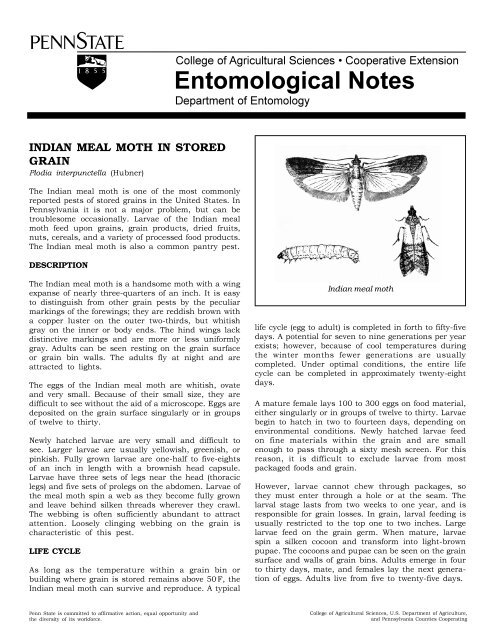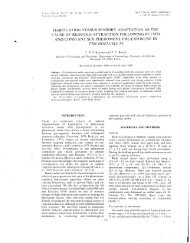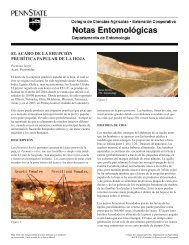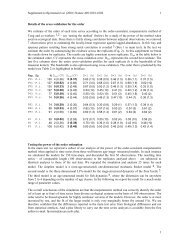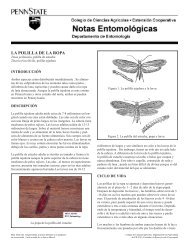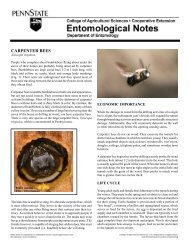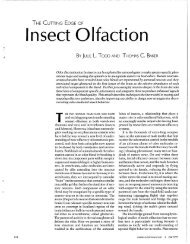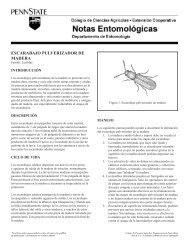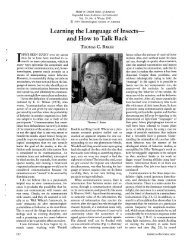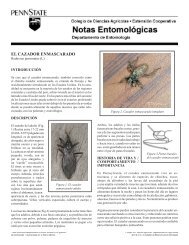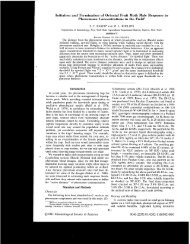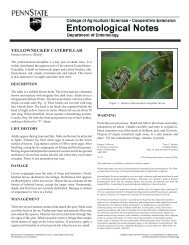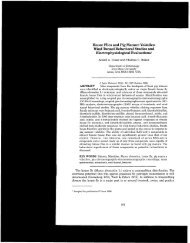PDF version of Indian Meal Moth Fact Sheet - Entomology
PDF version of Indian Meal Moth Fact Sheet - Entomology
PDF version of Indian Meal Moth Fact Sheet - Entomology
Create successful ePaper yourself
Turn your PDF publications into a flip-book with our unique Google optimized e-Paper software.
College <strong>of</strong> Agricultural Sciences • Cooperative Extension<br />
Entomological Notes<br />
Department <strong>of</strong> <strong>Entomology</strong><br />
INDIAN MEAL MOTH IN STORED<br />
GRAIN<br />
Plodia interpunctella (Hubner)<br />
The <strong>Indian</strong> meal moth is one <strong>of</strong> the most commonly<br />
reported pests <strong>of</strong> stored grains in the United States. In<br />
Pennsylvania it is not a major problem, but can be<br />
troublesome occasionally. Larvae <strong>of</strong> the <strong>Indian</strong> meal<br />
moth feed upon grains, grain products, dried fruits,<br />
nuts, cereals, and a variety <strong>of</strong> processed food products.<br />
The <strong>Indian</strong> meal moth is also a common pantry pest.<br />
DESCRIPTION<br />
The <strong>Indian</strong> meal moth is a handsome moth with a wing<br />
expanse <strong>of</strong> nearly three-quarters <strong>of</strong> an inch. It is easy<br />
to distinguish from other grain pests by the peculiar<br />
markings <strong>of</strong> the forewings; they are reddish brown with<br />
a copper luster on the outer two-thirds, but whitish<br />
gray on the inner or body ends. The hind wings lack<br />
distinctive markings and are more or less uniformly<br />
gray. Adults can be seen resting on the grain surface<br />
or grain bin walls. The adults fly at night and are<br />
attracted to lights.<br />
The eggs <strong>of</strong> the <strong>Indian</strong> meal moth are whitish, ovate<br />
and very small. Because <strong>of</strong> their small size, they are<br />
difficult to see without the aid <strong>of</strong> a microscope. Eggs are<br />
deposited on the grain surface singularly or in groups<br />
<strong>of</strong> twelve to thirty.<br />
Newly hatched larvae are very small and difficult to<br />
see. Larger larvae are usually yellowish, greenish, or<br />
pinkish. Fully grown larvae are one-half to five-eights<br />
<strong>of</strong> an inch in length with a brownish head capsule.<br />
Larvae have three sets <strong>of</strong> legs near the head (thoracic<br />
legs) and five sets <strong>of</strong> prolegs on the abdomen. Larvae <strong>of</strong><br />
the meal moth spin a web as they become fully grown<br />
and leave behind silken threads wherever they crawl.<br />
The webbing is <strong>of</strong>ten sufficiently abundant to attract<br />
attention. Loosely clinging webbing on the grain is<br />
characteristic <strong>of</strong> this pest.<br />
LIFE CYCLE<br />
As long as the temperature within a grain bin or<br />
building where grain is stored remains above 50 × F, the<br />
<strong>Indian</strong> meal moth can survive and reproduce. A typical<br />
<strong>Indian</strong> meal moth<br />
life cycle (egg to adult) is completed in forth to fifty-five<br />
days. A potential for seven to nine generations per year<br />
exists; however, because <strong>of</strong> cool temperatures during<br />
the winter months fewer generations are usually<br />
completed. Under optimal conditions, the entire life<br />
cycle can be completed in approximately twenty-eight<br />
days.<br />
A mature female lays 100 to 300 eggs on food material,<br />
either singularly or in groups <strong>of</strong> twelve to thirty. Larvae<br />
begin to hatch in two to fourteen days, depending on<br />
environmental conditions. Newly hatched larvae feed<br />
on fine materials within the grain and are small<br />
enough to pass through a sixty mesh screen. For this<br />
reason, it is difficult to exclude larvae from most<br />
packaged foods and grain.<br />
However, larvae cannot chew through packages, so<br />
they must enter through a hole or at the seam. The<br />
larval stage lasts from two weeks to one year, and is<br />
responsible for grain losses. In grain, larval feeding is<br />
usually restricted to the top one to two inches. Large<br />
larvae feed on the grain germ. When mature, larvae<br />
spin a silken cocoon and transform into light-brown<br />
pupae. The cocoons and pupae can be seen on the grain<br />
surface and walls <strong>of</strong> grain bins. Adults emerge in four<br />
to thirty days, mate, and females lay the next generation<br />
<strong>of</strong> eggs. Adults live from five to twenty-five days.<br />
Penn State is committed to affirmative action, equal opportunity and<br />
the diversity <strong>of</strong> its workforce.<br />
College <strong>of</strong> Agricultural Sciences, U.S. Department <strong>of</strong> Agriculture,<br />
and Pennsylvania Counties Cooperating
DAMAGE<br />
Direct damage to grain is the result <strong>of</strong> larvae feeding on<br />
the seed germ. In grain to be sold for human or animal<br />
consumption, meal moth feeding reduces the dry<br />
weight. At the same time, grain weight may actually<br />
increase because <strong>of</strong> water absorption; with an increase<br />
in water content mold can become a problem.<br />
The biggest reduction in value is the result <strong>of</strong> contamination<br />
by larvae that leave droppings and silken webs<br />
in the grain. The presence <strong>of</strong> live insects and insect<br />
parts can result in dockage <strong>of</strong> the grain when sold.<br />
MANAGEMENT<br />
On-farm grain storage, particularly corn, is increasing<br />
in Pennsylvania. Stored-grains <strong>of</strong>fer compact food<br />
sources for a number <strong>of</strong> insect pests. Good management<br />
practices are aimed at excluding these insects<br />
while maintaining grain quality. The longer grain is<br />
held in storage, the greater the need to maintain good<br />
management practices such as sanitation and residual<br />
sprays. When proper management is ignored,<br />
populations <strong>of</strong> insects which have been feeding and<br />
reproducing in grain residues are free to infest new<br />
grain. Once in the new grain, the insects continue to<br />
eat and reproduce. Substantial numbers <strong>of</strong> grain infesting<br />
insects can reduce the value <strong>of</strong> grain, or render<br />
it unfit for processing or feeding. <strong>Indian</strong> meal moths in<br />
the grain result in reduced grain weight and dockage<br />
because <strong>of</strong> contamination by fecal material and webbing.<br />
WARNING<br />
Pesticides are poisonous. Read and follow directions<br />
and safety precautions on labels. Handle carefully and<br />
store in original labeled containers out <strong>of</strong> the reach <strong>of</strong><br />
children, pets, and livestock. Dispose <strong>of</strong> empty containers<br />
right away, in a safe manner and place. Do not<br />
contaminate forage, streams, or ponds.<br />
Steven B. Jacobs<br />
Dennis Calvin<br />
Sr. Extension Associate Associate Pr<strong>of</strong>essor<br />
Dept. <strong>of</strong> <strong>Entomology</strong> Dept. <strong>of</strong> <strong>Entomology</strong><br />
April 1990<br />
SG-9 ã The Pennsylvania State University 2001<br />
This publication is available in alternative media on request.<br />
Where trade names are used, no discrimination is intended and no endorsement by The<br />
Pennsylvania State University or Pennsylvania Department <strong>of</strong> Agriculture is implied.<br />
Entomological Notes are intended to serve as a quick reference guide and should not be<br />
used as a substitute for product label information. Although every attempt is made to<br />
produce Entomological Notes that are complete, timely, and accurate, the pesticide user<br />
bears the responsibility <strong>of</strong> consulting the pesticide label and adhering to those directions.<br />
Issued in furtherance <strong>of</strong> Cooperative Extension Works, Acts <strong>of</strong> Congress May 8 and June<br />
30, 1914, in cooperation with the U.S. Department <strong>of</strong> Agriculture and the Pennsylvania<br />
Legislature. T.R. Alter, Director <strong>of</strong> Cooperative Extension, The Pennsylvania State<br />
University.<br />
The Pennsylvania State University is committed to the policy that all persons shall have<br />
equal access to programs, facilities, admission, and employment without regard to<br />
personal characteristics not related to ability, performance, or qualifications as<br />
determined by University policy or by state or federal authorities. It is the policy <strong>of</strong> the<br />
University to maintain an academic and work environment free <strong>of</strong> discrimination, including<br />
harassment. The Pennsylvania State University prohibits discrimination and harassment<br />
against any person because <strong>of</strong> age, ancestry, color, disability or handicap, national origin,<br />
race, religious creed, sex, sexual orientation, or veteran status. Discrimination or<br />
harassment against faculty, staff, or students will not be tolerated at The Pennsylvania<br />
State University. Direct all inquiries regarding the nondiscrimination policy to the<br />
Affirmative Action Director, The Pennsylvania State University, 201 Willard Building,<br />
University Park, PA 16802-2801, Tel 814-865-4700/V, 814-863-1150/TTY.<br />
Prevention is the best strategy to avoid <strong>Indian</strong> meal<br />
moth problems. Proper sanitation will help minimize<br />
the need to use pesticides. Good sanitation practices<br />
involve the removal <strong>of</strong> old grain and dust in and around<br />
the grain bin before storing new grain. This includes<br />
removing grain from corners, floors, and walls. Any<br />
grain remaining when a bin is emptied can harbor<br />
insect infestations which will move into the new grain.<br />
Another tactic which can be used to help prevent buildup<br />
<strong>of</strong> insect populations in stored grains is to periodically<br />
run the grain dryer fan. Increased air flow through<br />
the grain mass helps control the grain temperature<br />
and reduces moisture build-up, creating an unfavorable<br />
environment for the insects.<br />
Proper and consistent sanitation <strong>of</strong> the bins before the<br />
new grain is stored will usually protect grain up to six<br />
months. If the grain is to be stored for over six months,<br />
a residual insecticide application should be applied to<br />
the floor and structure walls. After the bin is filled, a<br />
residual spray should be applied to the grain surface.<br />
See the Penn State Agronomy Guide for specific control<br />
recommendations.<br />
Fumigation should be considered only if an emergency<br />
exists. Because fumigants are extremely hazardous,<br />
they must be handled with care.


